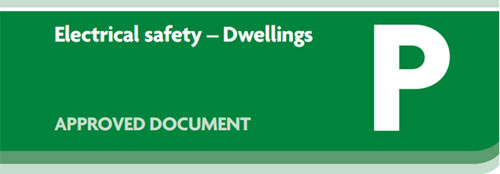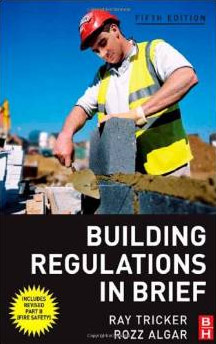Warning: To complete electrical works you must comply with Electrical Regulations – Click here for more information.
Please also see our project on the New Wiring and Cable Colours.
NOTE: This legislation does not apply in Scotland
Back in 2005 (Effective from 06th April 2006) the government introduced electrical safety instructions which form part of the building regulations in England and Wales. This states that much of the electrical work that is done in a home must meet these regulations.
The aim is to ensure that any electrical work done in any home is designed and installed so that it will protect people from electric shocks. This applies not just to you, the home owner, but anyone entering your home.
Legally you have a duty of care for anyone in your home and if a visitor is electrocuted and a result of electrical work you have done, you can be prosecuted.
Part P of the building regulations applies to all new electrical work and also any changes that are made to wiring and electrics in any dwelling. Electricians must comply to Part P of the building regulations in England and Wales. In Scotland they must comply with the Building Standards system.
You can download the full Approved Document P from the governments Planning Portal website on the link below.

The new look Approved Document P – Download here
Part P of the building regulations has been introduced to reduce the number of deaths, injuries and fires caused by faulty electrical installations and to make life much harder for "Cowboys" to leave electrical work in an unsafe condition. It lists the work in a dwelling which must be carried out by a competent person.
Competent Persons and Part P
Part P of the Building Regulations states that any electrical installations must be carried out by a competent person. This is in line with the competency expected from gas installers and goes far beyond just knowing which colour wires do what.
Competency, in this case, will mean a full, qualified knowledge of electrical installations. It will mean you have the ability to thoroughly check a circuit for safety and you will be able to issue a minor works certificate as a self certified "competent person".
Electricity kills and injures many people every year. A great many of these people are dead or injured because they tried installations which they did not understand. The Government is also intending, it is believed, to introduce a scheme whereby domestic installations are checked at regular periods to make sure they comply, and also when a house is sold or purchased.
This would mean of course that if you had an installation which was not correctly certified, your house insurance may not be valid.
The definition of competency is not simply someone with an understanding of how electricity works. It is very specific and includes the ability to test an electrical circuit thoroughly for faults both before, and after installation and the further ability to log these readings and report them to the appropriate electrical authority.
A competent person is a person or firm that has been approved by a Government approved Part P scheme.
What Electrical Work Can be Done Yourself?
DIY doctor will continue to publish projects involving minor works which are permitted under the new regulations, e.g. the addition of a lighting point or socket to an existing circuit but regrets that because of insurance restrictions, is now unable to answer specific electrical questions.
Please get any installations you have done checked by a qualified electrician and stay safe. More about part P can be found on the Planning Portal website: Part P Approved document P – Electrical safety.
The table below gives some idea of what is allowed and what is not but please check with the Building Control Department of your Local Council first as the regulations themselves are prone to change a fair amount.
Checklist for work controlled under Part P of the Building Regulations
| Work type | Notification required? – Areas outside of bathroom, shower room and kitchen | Notification required? – Within a bathroom, shower room or kitchen (special location) |
| New installation or complete rewire | Yes | Yes |
| Consumer unit change | Yes | Yes |
| Installation of a new shower circuit | Yes | Yes |
| Installation of an additional socket | No | Yes |
| Installation of an additional light | No | Yes |
| Addition of fused connection unit to ring final circuit | No | Yes |
| Installation of a new cooker circuit | Yes | Yes |
| Connection of a cooker to an existing connection unit | No | No |
| Installation or upgrade of main or supplementary equipotential bonding | No | Yes |
| Replacing damaged cable for a single circuit | No | No |
| Replacing damaged socket outlet | No | No |
| Replacing light fitting | No | No |
| Installation or fitting a storage heater, including final circuit | Yes | Yes |
| Fitting and final connection of a storage heater | No | No |
| Installation of extra low voltage lighting (not CE market sets) | Yes | Yes |
| Taking a new supply to a garden shed | Yes | N/A |
| Installation of a socket in a garden shed | Yes | N/A |
| Installation of a light fitting in a greenhouse | Yes | N/A |
| Installation of a pond pump, including supply | Yes | N/A |
| Installation of a hot air sauna | Yes | Yes |
| Installation of a solar photovoltaic power supply | Yes | Yes |
| Installation of ceiling or floor heating | Yes | Yes |
| Installation of a small scale generator | Yes | Yes |
| Installation of electrical underfloor heating | Yes | Yes |
The Homeowners Responsibilities under Approved Document P
It is a criminal offence as a homeowner or landlord not to ensure that all work carried out in a home meets with the Part P of the Building Regulations. All electrical work that is done in the house, garden, conservatories or any form of out building, including sheds, must meet with the regulations.
Currently, all work, except some very minor works, must be either reported to your Local Authority Building Control or be carried out by a qualified electrician who is registered on a government approved scheme.
If the works do not meet with the regulations the local authority can force the work to be removed or altered so that it does meet with the regulations. If you break these rules and an electrical fault is responsible for damage in your home you may find that your home insurance has been made invalid by the fact you have done the work yourself and cannot provide a minor certificate of works for it.
Before you start work you should inform your local building control of the changes that you are going to make, if you are not going to use an electrician who is registered on of the Part P approved schemes. You can find qualified electricians local to you on our Find a Tradesman page.
Getting Electrical Work Done by a Part P Qualified Electrician
If you have sensibly opted to get a qualified electrician to do the work, they will ensure that it is done to the UK national standard, BS 7671. When the works are complete they will give you a certificate that shows that the work has conformed to BS 7671. This certificate is known as Electrical Installation Certificate or Minor Work Certificate. They should also give you a Building Regulations Compliance Certificate which confirms that the work meets with the building regulations.
Changes and Updates to Approved Document P
Periodically changes and updates to Approved Document P are made and you need to be aware of these before your start any work. All changes are published and the most up to date version of the Approved Document P can be found on the Planning Portal website. Any of the above links will take you to the relevant section.
The last significant change occurred in April 2013, when the rules where relaxed slightly to allow more works to be carried out without notification, particularly removing some requirements for Kitchens and Outside works.
You must check the Planning Portal website before you start work – remember the law is very clear; it is the homeowner that is legally responsible for ensure that the work meets with the regulations. If in any doubt you should use a qualified electrician.
Practical Application of Part P and Policing It in Practice
We have recently received a question from an active home improver that illustrates the issues with practically applying the Part P guidelines and how they are policed.
Part P 2010 states:
Non-notifiable electrical installation work, like notifiable work, should be designed and installed, and inspected, tested and certified in accordance with BS7671.
Our reader asked:
Does that mean that any DIY electrical work needs to be certified by a “competent person” – even light fittings as sold in many DIY and home furnishing shops?
This is a great question and the answer is yes, in theory. But the IET accept that it is impossible to police and relaxation occurs through necessity. It is widely accepted that the main danger is working on or adapting new circuits and the legal enforcements, although theoretically applicable to all “non-competent” would not be applied to anything other than the recognised prohibited works as described on our page.
In this case our reader, having spoken to the local building Regulations Inspectors, concluded, that in his case it would be fine to change light fittings himself, but he should get a “competent” person to chase in a socket and supply.
Interestingly, the definition of “competent person” is not restricted to qualified. The inspector just needs to be satisfied that the person has sufficient competence so allowing DIYer’s to do some work. However, unless the work is notifiable, the inspector will not get the chance to make this assessment so the position remains ambiguous.
So our stance remains the same; if you’re in any doubt about what you are doing or whether it is legal, you should seek professional assistance. It is quite simply isn’t worth the risk not to!
Summary of the Building Regulations
Click on the book in the image below for an easy summary of the building regulations. This book is a must for those involved with any type of structural alteration. Even removing a wall in your home can require building regulation approval and when selling your home it can be difficult if you do not have legal approval, where necessary, for work done on your house.

Building Regulations in Brief

